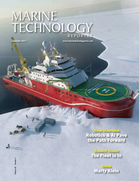GeoSphere: Mapping-while-drilling Evolution
By Claudio Paschoa
Logging-while-drilling (LWD) technologies have evolved significantly in the past decade. Today they integrate sophisticated algorithms that take advantage of the ever-increasing technical complexity combining mechanical, electrica, and software systems that are implemented downhole. These achievements helps the users gain a better understanding of the reservoir while bring drilling into a new area of efficiency and cost savings. Marine Technology Reporter’s Correspondent in Brazil spoke to Jean Seydoux, Program Manager for Advanced Reservoir Mapping Technologies for Drilling and Measurement at Schlumberger, about their GeoSphere Mapping-While-Drilling Service.
What were the breakthroughs in this technology’s development along the last five years?
In 2014, Schlumberger introduced the GeoSphere technology, the first-ever reservoir mapping-while-drilling service that enables customers to map their reservoirs using unprecedented depth of investigation measurements around the wellbore coupled with a novel mathematical inversion methodology.
Using deep, directional electromagnetic measurements, the GeoSphere service reveals subsurface-bedding and fluid-contact details more than 100 ft [30 m] from the wellbore. This reservoir-scale view provides an unprecedented depth of investigation, enabling operators to optimize landing, maximize reservoir exposure, and refine field development plans. By integrating real-time reservoir maps with seismic surveys, interpretation of reservoir structure and geometry can be refined, revolutionizing field development strategy.
What different fields of research were involved in developing the GeoSphere reservoir mapping-while-drilling service?
Mechanical, electrical, and software engineering that deliver deep directional measurements are at the core of the hardware development. From these measurements, a resistivity map of the reservoir is inverted using a novel stochastic process that allows the drilling team and geoscientists (such as petrophysicists, geologists and reservoir engineers) to first understand and then steer within a geological structure tens of meters away from the borehole—all in real time.
By revealing details of structural dips and fluid boundaries in geological structures, the real-time mapping data provides operators with information critical to avoiding undesired exits into nonproductive layers.
How does mapping-while-drilling system work operationally?
The GeoSphere mapping-while-drilling service follows a standard pre-job modeling, real-time execution, and post-job evaluation that characterize the well placement process but with a much deeper understanding of the reservoir structure.
When it comes to steering, the GeoSphere service detects individual layers in horizontal sections radially—as mentioned earlier—more than 100 ft [30 m] from the wellbore, exceeding the formation coverage of conventional logging-while drilling technologies. Combined with surface seismic data, this amount of zonal coverage gives geoscientists and drilling engineers the capability to extend laterals—even in the most complex geological settings—within the sweet spot.
As for mapping, the GeoSphere service maps the reservoir top and base, providing data on the presence of lateral heterogeneities, subsurface unconformities, and reservoir geometry. Asset teams can then integrate all data from the service to optimize production and reservoir management. With complete well development plans, operators have a greater likelihood of successfully enhancing recovery techniques and exceeding expectations for the reservoir.
Finally, mapping data from the GeoSphere service can be integrated into 3D reservoir models to optimize drilling operations and completion designs, leading to production improvement and better field development strategies.
What are the main advantages of using the GeoSphere service in relation to traditional pilot drilling?
One of the main advantages of the service is to avoid drilling a pilot hole, which is a costly operation, especially when drilling offshore. Pilot holes are often drilled to evaluate the formation, but that doesn’t necessarily mitigate risks in shallow or complex reservoir. Productivity of the well can be impacted by shallow landings, where too much of the section is drilled in the overburden, which becomes a major challenge for completions, or deep landings, causing early water breakthroughs and resulting in more attic oil.
By dynamically adjusting the trajectory of the well based on the surrounding geology, the GeoSphere service is much more efficient than the traditional pilot hole operations and allows a more optimum positioning of the well. Due to the extended radial depth of investigation, the service enables the operators to see more than 100 ft around the wellbore, revealing the reservoir boundaries ahead of time to accurately land the well. This eliminates the need for pilot hole drilling and results in more efficient well construction.
What were the main challenges in developing the mapping-while-drilling service for commercial use?
Well placement poses a wide range of critical issues, such as adjusting to reservoir uncertainties and various drilling risks. To address these challenges, the technology was designed to be configurable and flexible to maximize its envelope of applications. The GeoSphere service is the first drilling technology with the sensors and frequencies that can be optimized to a specific application such as landing or navigation within a reservoir in low to very high resistivity regimes.
This translates into the maximized reservoir exposure, ability to stay in the sweet spot and the modification of field development plans. The operators now have the right tools to fully understand their reservoirs in an efficient and cost-effective manner.
What are the main components of the mapping-while-drilling service and how is the service deployed offshore?
The main components of the service, which is adaptable to the challenges of the well, consist of separate drilling subs hosting electromagnetic transmitters and receiver configured in a standard bottom hole assemblydrill string. When drilling, the data acquired by the system is transmitted onshore and processed on a high power computer cluster to provide a continuous resistivity map of the reservoir that helps the operator to take well placement decisions in real time.
Two offshore case studies are worth mentioning here. In the Balder field, North Sea, the GeoSphere reservoir mapping-while-drilling service enabled the operator to eliminate the need for pilot holes and improve landing success. The challenge was to distinguish targeted sands from nontargeted sands when drilling through a complex formation to land effectively and optimize production while eliminating the need for costly pilot holes. The GeoSphere service mapped the top of the massive sands from more than 20-m [66-ft] true vertical depth above, ensuring a safer and more optimal landing result. Also, the operator was able to detect the oil/water contact while landing the 12 1/4-in section prior to penetrating the reservoir.
In the Caspian Sea, the GeoSphere service mapped formation boundaries that were located up to 24 m from the wellbore, allowing the operator to geosteer the well with only 5 trajectory changes compared with an average 15-20 in previous wells. In this project, Schlumberger achieved world record for the new service, logging 4,908 m in one run, 88.5% net to gross.
How does mapping-while-drilling help increase ROP, improve wellbore stability and hole quality, and optimize well placement?
By seeing geological and reservoir features deeper and earlier the wellbore tortuosity is optimized and correction to the trajectory can be smoother and more efficient. The outcome is a higher ROP with a much improved wellbore position with respect to the main reservoir target.
How and where is mapping-while-drilling being used in deep water offshore Brazil?
GeoSphere was first used in the Campos basin, offshore Brazil, for landing, pilot hole avoidance, and horizontal navigation by various operators, accounting for approximately 20% of the total world application so far.
What were the benefits Schlumberger found in using mapping-while-drilling offshore Brazil, in the North Sea and in the Barents Sea?
A close interaction with operators both during the pre-job phase and in real time is paramount. The collaborative approach enables the Schlumberger experts to gain a much deeper understanding of the operator’s challenges from landing to reservoir characterization. Previous challenges associated with well placement that were unattainable before— such as drilling in very thin, discontinued, or compartmentalized reservoirs—can now be fully addressed.
The offshore Brazil case study demonstrates how the reservoir mapping-while-drilling service investigated 100 ft from wellbore in real time to detect reservoir boundaries. As a result, the operator accurately landed three wells, each with multiple targets in channel sands, leading to optimized drain trajectories.
In the Balder field, North Sea, the GeoSphere service enabled the operator to eliminate the need for pilot holes and improve landing success.
In the Barents Sea, the GeoSphere service revealed that the reservoir was thicker but more heterogeneous than anticipated—useful information for geosteering and for postwell evaluation activity.
What future uses do you foresee for the mapping-while-drilling service worldwide?
The service is rapidly becoming a standard application to reduce drilling risks and understand the reservoir to the fullest. Such a service is needed as operators discover new opportunities and face different challenges in the ever-changing oil and gas environment.


 December 2025
December 2025



